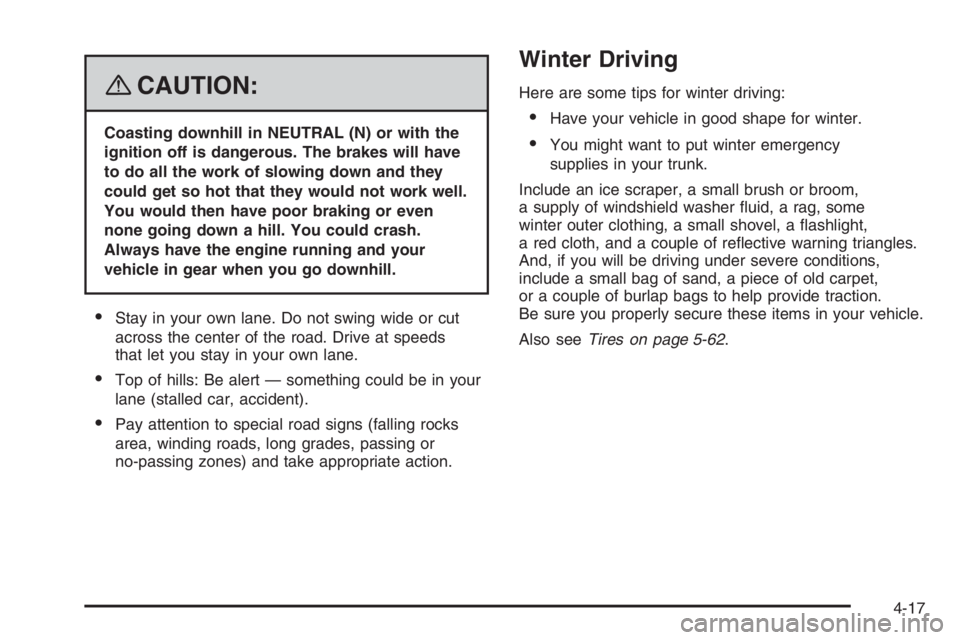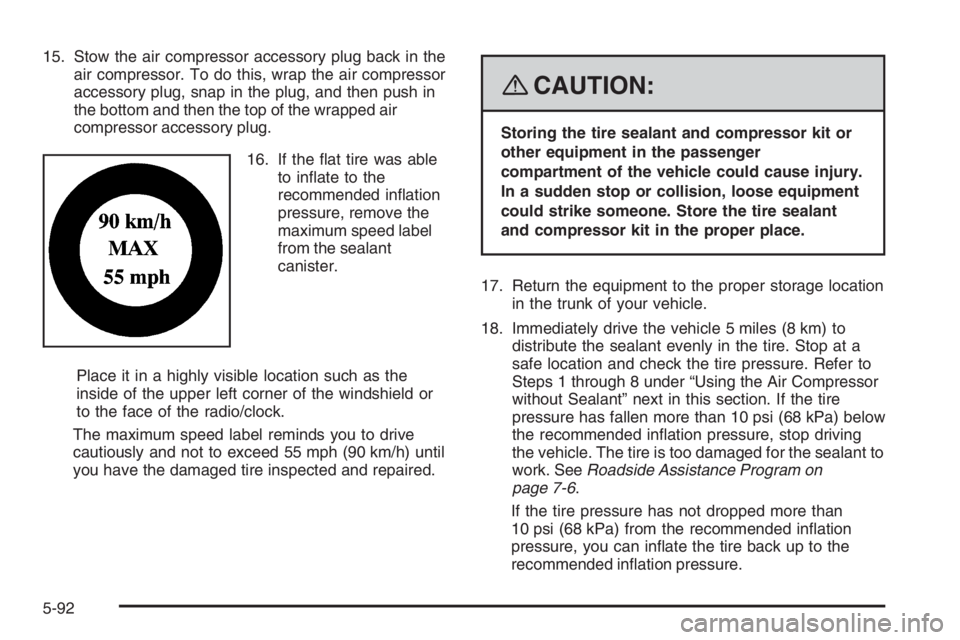Page 251 of 450

{CAUTION:
Coasting downhill in NEUTRAL (N) or with the
ignition off is dangerous. The brakes will have
to do all the work of slowing down and they
could get so hot that they would not work well.
You would then have poor braking or even
none going down a hill. You could crash.
Always have the engine running and your
vehicle in gear when you go downhill.
Stay in your own lane. Do not swing wide or cut
across the center of the road. Drive at speeds
that let you stay in your own lane.
Top of hills: Be alert — something could be in your
lane (stalled car, accident).
Pay attention to special road signs (falling rocks
area, winding roads, long grades, passing or
no-passing zones) and take appropriate action.
Winter Driving
Here are some tips for winter driving:
Have your vehicle in good shape for winter.
You might want to put winter emergency
supplies in your trunk.
Include an ice scraper, a small brush or broom,
a supply of windshield washer �uid, a rag, some
winter outer clothing, a small shovel, a �ashlight,
a red cloth, and a couple of re�ective warning triangles.
And, if you will be driving under severe conditions,
include a small bag of sand, a piece of old carpet,
or a couple of burlap bags to help provide traction.
Be sure you properly secure these items in your vehicle.
Also seeTires on page 5-62.
4-17
Page 261 of 450

{CAUTION:
Things you put inside your vehicle can
strike and injure people in a sudden stop
or turn, or in a crash.
Put things in the trunk of your vehicle.
In a trunk, put them as far forward
as you can. Try to spread the weight
evenly.
Never stack heavier things, like
suitcases, inside the vehicle so that
some of them are above the tops
of the seats.
Do not leave an unsecured child
restraint in your vehicle.
When you carry something inside the
vehicle, secure it whenever you can.
Do not leave a seat folded down
unless you need to.
Towing
Towing Your Vehicle
Consult your dealer/retailer or a professional towing
service if you need to have your disabled vehicle towed.
SeeRoadside Assistance Program on page 7-6.
If you want to tow your vehicle behind another vehicle
for recreational purposes (such as behind a motorhome),
see “Recreational Vehicle Towing” following.
Recreational Vehicle Towing
Recreational vehicle towing means towing your vehicle
behind another vehicle – such as behind a motorhome.
The two most common types of recreational vehicle
towing are known as dinghy towing, towing your vehicle
with all four wheels on the ground, and dolly towing,
towing your vehicle with two wheels on the ground and
two wheels up on a device known as a dolly.
With the proper preparation and equipment, many
vehicles can be towed in these ways. See “Dinghy
Towing” and “Dolly Towing,” following.
4-27
Page 280 of 450

Filling a Portable Fuel Container
{CAUTION:
Never �ll a portable fuel container while it is in
your vehicle. Static electricity discharge from
the container can ignite the fuel vapor. You
can be badly burned and your vehicle damaged
if this occurs. To help avoid injury to you and
others:
Dispense fuel only into approved
containers.
Do not �ll a container while it is inside a
vehicle, in a vehicle’s trunk, pickup bed, or
on any surface other than the ground.
Bring the �ll nozzle in contact with the
inside of the �ll opening before operating
the nozzle. Contact should be maintained
until the �lling is complete.
Do not smoke while pumping fuel.
Do not use a cellular phone while
pumping fuel.
Checking Things Under
the Hood
{CAUTION:
An electric fan under the hood can start up
and injure you even when the engine is not
running. Keep hands, clothing, and tools away
from any underhood electric fan.
{CAUTION:
Things that burn can get on hot engine parts
and start a �re. These include liquids like fuel,
oil, coolant, brake �uid, windshield washer and
other �uids, and plastic or rubber. You or
others could be burned. Be careful not to drop
or spill things that will burn onto a hot engine.
5-10
Page 328 of 450
Taillamps, Turn Signal, and
Stoplamps
A. Taillamp
B. Taillamps, Turn Signal
and Stoplamps
1. Open the trunk. SeeTrunk on page 2-14for more
information.
2. Remove the convenience net, if equipped, by
removing the net hook attachments.
3. Remove the plastic cap from the trunk trim.
4. Pull the trunk trim and carpet away from the back of
the trunk.
5. Remove the bottom bolt and two nuts.6. Remove the taillamp
assembly by pulling it
out from the vehicle.
7. Turn the appropriate
lamp socket a quarter
turn counterclockwise
and remove it.
8. Remove the old bulb.
5-58
Page 329 of 450
9. Replace with a new bulb into the socket and turn
the lamp socket clockwise to install it.
10. Reinstall the taillamp assembly by reversing
Steps 2 through 5.
Back-Up Lamps
The back-up lamps are located on the trunk lid.
To replace the back-up lamp bulb(s):
1. Open the trunk. SeeTrunk on page 2-14for more
information.2. Turn the appropriate lamp socket a quarter turn
counterclockwise and remove it.
3. Remove the old bulb.
4. Put the new bulb into the lamp socket.
5. Turn the bulb a quarter turn clockwise to reinstall it.
5-59
Page 330 of 450
License Plate Lamp
To replace one of these bulbs:
1. Open the trunk. SeeTrunk on page 2-14
2. Turn the appropriate lamp socket a quarter turn
counterclockwise and remove it.
3. Remove the old bulb.
4. Put the new bulb into the lamp socket.
5. Turn the bulb a quarter turn clockwise to reinstall it.
Replacement Bulbs
Exterior Lamps Bulb Number
Back-Up Lamp 3157
Front Parking/Turn Signal Lamp3757 NAK* or
5702 KA**
Front Sidemarker and License
Plate Lamp194
Headlamps
High-Beam Halogen 9005
Low-Beam Halogen 9006
Stop/Taillamp/Turn Signal Lamps 3057
* Base Models with the Optional Fog Lamps
** For Lamps Not Equipped with the Fog Function and
GXP Models
For replacement bulbs not listed here, contact your
dealer/retailer.
5-60
Page 358 of 450
Accessing the Tire In�ator Kit
To access the tire in�ator kit:
1. Open the trunk. SeeTrunk on page 2-14for more
information.
2. Locate the tire in�ator kit by lifting up the carpet.
3. Remove the in�ator kit
cover by turning the
center nut
counterclockwise.
4. Remove the in�ator kit by pulling it straight out of
the foam container.
5-88
Page 362 of 450

15. Stow the air compressor accessory plug back in the
air compressor. To do this, wrap the air compressor
accessory plug, snap in the plug, and then push in
the bottom and then the top of the wrapped air
compressor accessory plug.
16. If the �at tire was able
to in�ate to the
recommended in�ation
pressure, remove the
maximum speed label
from the sealant
canister.
Place it in a highly visible location such as the
inside of the upper left corner of the windshield or
to the face of the radio/clock.
The maximum speed label reminds you to drive
cautiously and not to exceed 55 mph (90 km/h) until
you have the damaged tire inspected and repaired.
{CAUTION:
Storing the tire sealant and compressor kit or
other equipment in the passenger
compartment of the vehicle could cause injury.
In a sudden stop or collision, loose equipment
could strike someone. Store the tire sealant
and compressor kit in the proper place.
17. Return the equipment to the proper storage location
in the trunk of your vehicle.
18. Immediately drive the vehicle 5 miles (8 km) to
distribute the sealant evenly in the tire. Stop at a
safe location and check the tire pressure. Refer to
Steps 1 through 8 under “Using the Air Compressor
without Sealant” next in this section. If the tire
pressure has fallen more than 10 psi (68 kPa) below
the recommended in�ation pressure, stop driving
the vehicle. The tire is too damaged for the sealant to
work. SeeRoadside Assistance Program on
page 7-6.
If the tire pressure has not dropped more than
10 psi (68 kPa) from the recommended in�ation
pressure, you can in�ate the tire back up to the
recommended in�ation pressure.
5-92